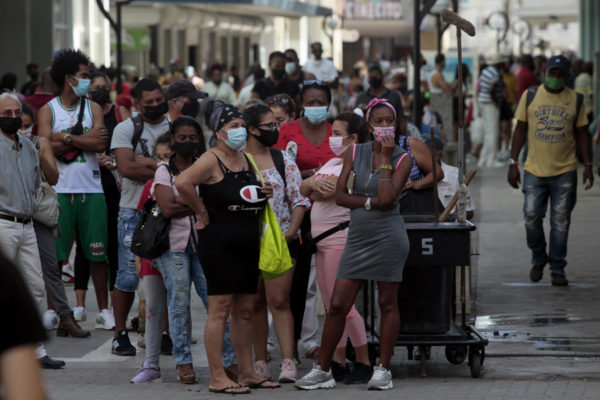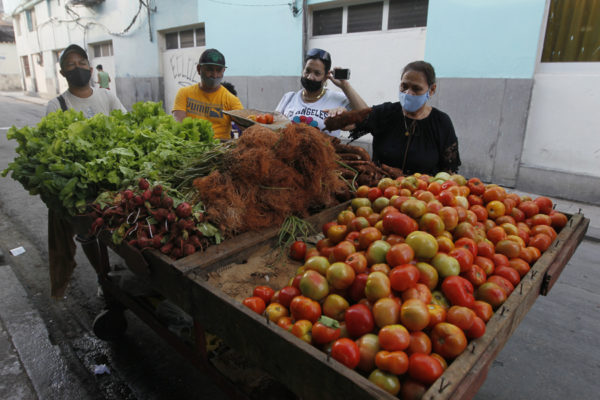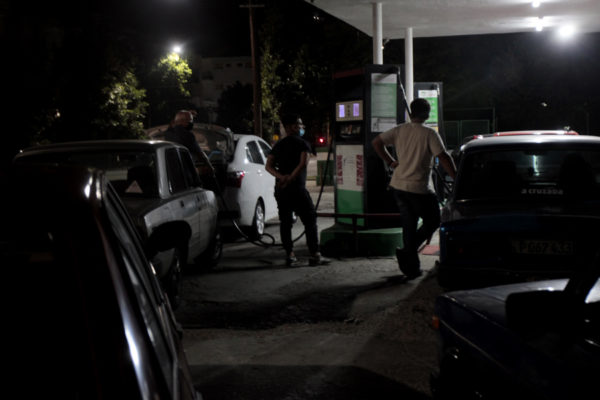Catalysts Persist in Cuba a Year after July 11th Protests

The Government says that the US is using the hardships as part of the embargo, decreed in 1962, to provoke a social uprising.
By Luis Brizuela (IPS)
HAVANA TIMES – Despite COVID-19 being somewhat in check now, some economic incentives, inflation and inequality in access to food and other products, continue amidst many other factors that triggered, a year ago, the greatest protests seen in Cuba, since 1994.
“Some things have changed in 12 months, others haven’t at all. I feared for my life last July; I was locked up at home because of the pandemic. Now, we go outside, without a face mask even. I was recently given my second Abdala booster,” after the initial 3-dose vaccination scheme, pensioner Lidia Batista said in an interview with IPS from Holguin, 685 kms to the east of Havana.
Developed by the national biotech sector, Abdala, Soberana 02 and Soberana Plus vaccines, which are pending approval by the World Health Organization (WHO), have allowed the country to inoculate 90% of the 11.1 million inhabitants on the island against Sars-CoV-2, according to statistics from the Ministry of Public Health.
This vaccination rate and a drop in COVID-19-related deaths and infections, led to borders reopening on November 15th. With the end of lockdown and social distancing measures, strategic activities such as tourism, as well as cultural and social activities, started up again.
“One thing that hasn’t been fixed is the economy. Prices are sky-high. There are also medicine shortages and blackouts continue. You can’t buy a lot of food items because they are so expensive,” Batista said.
Measures with different results
“The Cuban Government has had very little room to maneuver and change things. Shortages and inflation continue to impact Cubans’ everyday lives. There isn’t any space to continue increasing public expenditure, foreign debt or imports,” Cuban economist Pavel Vidal, a professor at the Pontifical Xavierian University in Cali, Colombia, told IPS from this city.
According to experts, discontent felt on Cuban streets was not only the result of shortages of food and basic essentials.
They argue it also had to do with the economic reforms process that began on January 1, 2021, which multiplied prices, raised inflation and reduced many families’ purchasing power, despite higher wages and pensions.
Meanwhile, the partial dollarization of the economy became worse, along with more establishments selling food in foreign currency,
The Government defends these establishments as a means of collecting foreign currency to, partly, supply empty stores selling in pesos, which is the currency Cubans are paid their wages in, in a country that needs to import approximately 70% of its food.
Nevertheless, economists and social scientists have pointed out that this division in access to basic essentials only steps up inequality.

The Government admits there have been “problems” in the design and implementation of the reforms process.”
Cuba’s Office of Statistics and Information (ONEI) reported 77.3% growth of the Consumer Price Index in 2021, although foreign organizations studying the Cuban economy believe that inflation could amount to 10 times this figure.
These factors went hand-in-hand with a more severe economic crisis due to a stricter embargo imposed by former US president Donald Trump (2017-2021), and two hundred+ sanctions against the island during his administration.
It’s hard to estimate the possible impact of measures announced by the Biden governmemt in May, geared towards resuming flights from the US to several provinces, eliminating the cap on remittances and reauthorizing licenses for group travel of US citizens for educational and research purposes.
Likewise, Vidal pointed out that approving micro, small and medium-sized enterprises (MSMEs) “represents an important structural change within Cuba’s [centrally-planned] economic system.”
Up until now, 4098 private MSMEs, 51 state-owned companies and 56 non-agricultural cooperatives were approved, after they were given a green light in September 2021, after years of lobbying, as part of a strategy to encourage production of goods and services, as well as increasing possible sources of employment.
Results from other government measures implemented in the past two years to encourage agriculture, cattle farming and the autonomy of state-led companies, still remain to be seen.
Up until December 31st, special authorization will be granted for people to travel to Cuba with limitless hand luggage and tax-free imports on food, medicine, medical supplies, and toiletries, to alleviate chronic shortages.

11J in context
The 11J protests took place when the island was experiencing a surge in COVID-19 infections and deaths, and oxygen shortages pushed public health services in some of Cuba’s 15 provinces to the brink.
Popular discontent grew with blackouts due to constant breaks and repairs of old power plants which supply 90% of the country’s electricity generation, along with diesel engines.
In recent weeks, many of the electricity generating plants reported partial break downs or underwent maintenance, which has led to more bothersome blackouts.
According to Miguel Diaz-Canel’s Government, protests in some 40 cities demanding economic and political changes, without visible leadership, were praised from the US and other countries as part of an “intense communicational/political operation” geared towards “encouraging riots and instability” and leading to a “regime change.”
The Government says that the US Government is using deprivations as part of the embargo, decreed in 1962, to provoke a social uprising.
Acts of vandalism and violence also took place against commercial establishments, vehicles and law enforcement, and in addition to those injured, one person was reported dead.
“While I don’t share the violent means of some people that day, I believe that the protests sent a clear message, that an important group of people weren’t “confused” [as the president stated], but overwhelmed by a life that is getting harder and harder,” economist Hanser Castillo told IPS. Castillo also works as an accountant for private management companies and rents his home out to tourists in Havana.
According to Castillo, “we also can’t ignore the fact that more and more young people are choosing to leave the country because they see no prospects for their future.”
From October 1, 2021, up until May 31, 2022, a total of 140,602 Cuban migrants – the equivalent of 1.2% of the island’s population – were arrested crossing over to the US illegally, mainly on the US-Mexican border, according to statistics from the US Customs and Border Protection.
In January, Cuba’s Public Prosecutor’s Office announced that 790 citizens were being taken to trial for “attacking the constitutional order and stability of our socialist State” during the protests last July.
In recent weeks, sentences were issued by courts in various provinces against those charged with crimes, mostly for “sedition; sabotage; theft and violence; attacks; contempt and public disorder,” with sentences for up to 25 years in prison.
Some citizens were absolved, and in some other cases the punished were issued labor with and without imprisonment and restricted freedom.
Family members of the accused, activists and international organizations point out that these trials took place with fabricated evidence, a lack of safeguards and excessive sentences.
Legal authorities say that court hearings respected due process.

Prospects
After 11J, the Government identified at least 67 of these communities in the Cuban capital, where they injected resources to build and repair buildings, pave roads, install water pipes and a sewage system, and to revive culture.
While plans forecast 4% GDP growth this year, Vidal says that short-term recovery in Cuba will depend on external factors, especially those linked to tourism, US sanctions and the international economic situation.
He added that “it’s key to steam ahead with agricultural reforms, close and restructure 400 state-run companies that have reported losses… and currency reform needs to be completed, which was only half-done, as divisions, the dual-currency system and different exchange rates remain in place.
Regarding macro-economic policy, the economist summarized the following from Cali: “the priority needs to be a stabilizing plan to reduce the fiscal deficit – estimated at 18.3% of GDP in 2021 – and inflation.”





